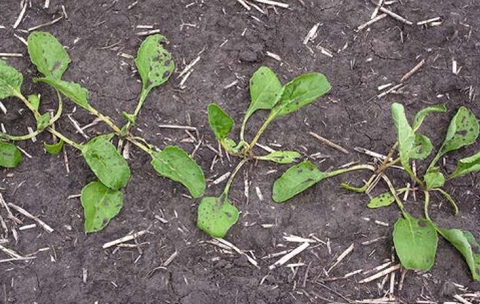I. Growth regulators (SOA 4, SOA 19)
The growth-regulator herbicides consist of synthetic auxin and auxin transport inhibitor compounds. These include
- Phenoxy acetic acid.
- Benzoic acid.
- Pyridine.
- Arylpicolinate.
- Pyrimidine
- Quinoline.
Growth-regulator herbicides can act at multiple sites in a plant to disrupt hormone balance and protein synthesis and thereby cause a variety of plant growth abnormalities.
Growth-regulator herbicides control broadleaf weeds, and most will injure sugarbeet. Herbicides in this group can move in the xylem and phloem to areas of new plant growth. As a result, many herbicides in this group are effective on perennial and annual broadleaf weeds.
Herbicide uptake primarily is through the foliage, but root uptake also may occur.
Auxin transport inhibitors, such as diflufenzopyr, inhibit the movement of auxinic compounds from meristematic (actively growing) cells. Thus, when combined with an auxin herbicide such as dicamba, the herbicide moves into these cells but cannot move out, resulting in greater concentrations of the auxininic herbicide within meristematic regions.
Herbicide use
- 2,4-D-amine, -choline or -ester salt for barley, corn, oat,
pastures, rangeland, Enlist soybean and wheat.
• MCPA for alfalfa, barley, oat, pastures, rangeland and
wheat.
• 2,4-DB for alfalfa and soybean.
Injury symptoms
All phenoxy acetic acids produce identical symptoms in sugarbeet. Sugarbeet leaves will lay flat on the ground within a few hours after exposure, and leaves may remain more prostrate than normal for the rest of the growing season if injury is severe (Photo 1).
Leaf petioles exhibit twisting, also called epinasty. Sugarbeet exposed to phenoxy acetic acids in the cotyledon to early four-leaf stage may develop fused petioles and a symptom called “celery stalking” or “trumpeting” (Photo 2).
Phenoxy acetic acid herbicides on larger sugarbeet will not produce celery stalking. New leaf growth generally will resume at about six to 10 days after exposure to phenoxy acetic acids. New leaves will often will be malformed, with wrinkled leaf margins, parallel veins or leaf strapping (Photo 3).
Rapid initiation of new leaf growth suggests less sugarbeet injury and less sugarbeet yield loss than delayed initiation of new leaf growth. Sugarbeet injured with phenoxy acetic acids should be processed immediately after harvest because injured sugarbeet roots do not store as well as noninjured roots.
Site of action
Specific site or sites unknown; one or more auxin receptors are likely candidates.
Herbicide use
Dicamba acid and BAPMA, DMA, DGA, Na+, IPA or DEA salt (Banvel, Clarity, DiFlexx, Engenia, Status,XtendiMax and FeXapan) for barley, corn, oat, rangeland, RR2 Xtend soybean and wheat.
Injury symptoms
Dicamba (Banvel, etc.) causes sugarbeet injury that is visually indistinguishable from phenoxy acetic acid injury (Photos 4 and 5). Dicamba may have sufficient residual in the soil to reduce emergence and to injure emerging sugarbeet (Photo 6). Emerging seedlings may be twisted, and development of the first true leaves may be inhibited.
Dicamba residual in soil can cause “trumpeting” symptoms, which also can be caused by early postemergence exposure from phenoxy acetic acid herbicides. Like with 2,4-D, new leaves often will be malformed, with wrinkled leaf margins, parallel veins or leaf strapping (Photo 7).
Site of action
Specific site or sites unknown; one or more auxin receptors are likely candidates.
Herbicide use
- Aminopyralid (Milestone) for pastures and rangeland.
- Clopyralid (Stinger) for corn, oat, pastures, rangeland, sugar beet and wheat.
- Fluroxypyr (Starane) for barley, corn, oat and wheat.
- Picloram (Tordon) for pastures and rangeland.
- Triclopyr (Garlon) for pastures.
- Halauxifen (Elevore) for fallow ground ahead of multiple crops.
- Aminocyclopyrachlor (Method) for non-crop areas.
- Quinclorac (Facet) for pastures, rangeland and wheat.
Injury symptoms
Injury symptoms are very similar to the phenoxy acetic acids or benzoic acids (Photo 8). Stinger is registered on sugarbeet but can cause leaves to roll upward from the edges in some environments or at high rates (Photo 9).
Sugarbeet damage, although not common, occurs more frequently on older plants (six to 10 leaves) than younger plants (two to four leaves). Injury is transient and does not cause yield loss.
Site of action
Specific site or sites are unknown; one or more auxin receptors are likely candidates.
Herbicide use
Diflufenzopyr + dicamba (Status) for corn.
Injury symptoms
Diflufenzopyr has minor herbicide activity when applied alone.
Site of action
Specific site or sites unknown, but it likely is one or more auxin transport proteins.
CAUTION: Mention of a pesticide or use of a pesticide label is for educational purposes only. Always follow the pesticide label directions attached to the pesticide container you are using. Be sure that the area you wish to treat is listed on the label of the pesticide you intend to use. Remember, the label is the law.
Return to herbicide families | Next herbicide family
Reviewed in 2018


